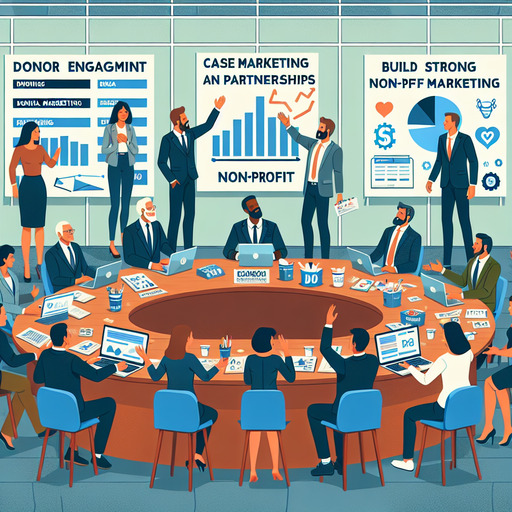
-
Table of Contents
- Effective Non-Profit Marketing Strategies: Engaging Donors and Amplifying Your Cause
- Understanding the Importance of Non-Profit Marketing
- 1. Building a Strong Non-Profit Brand
- 2. Leveraging Digital Marketing for Non-Profits
- 3. Enhancing Donor Engagement
- 4. Utilizing Cause Marketing and Partnerships
- Conclusion
- Questions and Answers
Effective Non-Profit Marketing Strategies: Engaging Donors and Amplifying Your Cause
In today’s competitive landscape, non-profit organizations must adopt innovative marketing strategies to stand out and effectively engage donors. With limited resources, non-profits need to maximize their outreach efforts to ensure their message resonates with potential supporters. This article explores actionable strategies for non-profit marketing, focusing on digital platforms, branding, and donor engagement.
Understanding the Importance of Non-Profit Marketing
Non-profit marketing is crucial for raising awareness, attracting donors, and driving engagement. By leveraging effective marketing strategies, non-profits can amplify their cause and make a significant impact. Let’s delve into some key strategies that can help your organization thrive.
1. Building a Strong Non-Profit Brand
Your brand is the face of your organization. A strong non-profit brand communicates your mission, values, and impact effectively. Here are some steps to build a compelling brand:
- Define Your Mission: Clearly articulate your mission and values. Ensure that your messaging is consistent across all platforms.
- Create a Visual Identity: Develop a logo and color scheme that reflects your organization’s personality and mission.
- Tell Your Story: Use storytelling to connect emotionally with your audience. Share success stories and testimonials to highlight your impact.
For example, Charity: Water has successfully built a recognizable brand by focusing on transparency and storytelling, which has helped them engage a global audience.
2. Leveraging Digital Marketing for Non-Profits
Digital marketing offers cost-effective ways to reach a broader audience. Here are some strategies to consider:
- Social Media Engagement: Use platforms like Facebook, Instagram, and Twitter to share updates, engage with followers, and promote fundraising campaigns.
- Email Marketing: Build a mailing list to keep supporters informed about your activities and upcoming events. Personalize emails to enhance engagement.
- Content Marketing: Create valuable content such as blog posts, videos, and infographics to educate and inspire your audience.
Consider the case of the ALS Association’s Ice Bucket Challenge, which went viral on social media, raising over $115 million for ALS research.
3. Enhancing Donor Engagement
Engaging donors is essential for building long-term relationships. Here are some strategies to enhance donor engagement:
- Personalized Communication: Address donors by name and tailor your messages to their interests and past contributions.
- Show Appreciation: Regularly thank donors for their support and update them on how their contributions are making a difference.
- Offer Involvement Opportunities: Encourage donors to participate in events, volunteer, or become advocates for your cause.
For instance, Habitat for Humanity engages donors by offering hands-on volunteer opportunities, allowing them to see the impact of their contributions firsthand.
4. Utilizing Cause Marketing and Partnerships
Cause marketing involves partnering with businesses to promote a social cause. This strategy can increase visibility and attract new supporters. Consider these steps:
- Identify Potential Partners: Look for businesses that align with your mission and values.
- Develop Mutually Beneficial Campaigns: Create campaigns that benefit both your organization and the partner business.
- Leverage Cross-Promotion: Use each other’s platforms to reach a wider audience and amplify your message.
An example of successful cause marketing is the partnership between (RED) and various companies, which has raised millions for HIV/AIDS programs.
Conclusion
Effective non-profit marketing strategies are essential for engaging donors and amplifying your cause. By building a strong brand, leveraging digital marketing, enhancing donor engagement, and utilizing cause marketing, your organization can make a significant impact. Remember, the key is to communicate your mission clearly and connect with your audience on an emotional level.
For more insights on non-profit marketing strategies, visit this Wikipedia page on Nonprofit Organizations.
Questions and Answers
Q1: How can non-profits effectively use social media for marketing?
A1: Non-profits can use social media to share impactful stories, engage with followers, and promote fundraising campaigns. Consistent posting and interaction with the audience are key to building a strong online presence.
Q2: What are some cost-effective digital marketing strategies for non-profits?
A2: Email marketing, content marketing, and social media engagement are cost-effective strategies. These platforms allow non-profits to reach a broad audience without significant financial investment.
Q3: How can non-profits build long-term relationships with donors?
A3: Personalized communication, regular appreciation, and offering involvement opportunities are effective ways to build long-term relationships with donors. Keeping donors informed about the impact of their contributions is also crucial.
If you’re interested in learning more about our services or have questions about this blog, please reach out to us via our contact page.